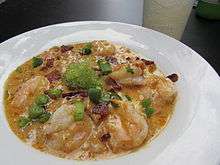Lowcountry cuisine
| Part of a series on |
| American cuisine |
|---|
|
Regional cuisines
|
|
Ingredients and foods |
|
Ethnic and cultural |
|
Holidays and festivals |
|
Lowcountry cuisine is the cooking traditionally associated with the South Carolina Lowcountry and the Georgia coast. While it shares features with Southern cooking, its geography, economics, demographics, and culture pushed its culinary identity in a different direction from regions above the fall line. With its rich diversity of seafood from the coastal estuaries, its concentration of wealth in Charleston and Savannah, and a vibrant African cuisine influence, Lowcountry cooking has strong parallels with New Orleans and Cajun cuisine.
Region
The lowcountry includes the coastal regions of South Carolina and Georgia. There is a difference of opinion as to what exactly the South Carolina Lowcountry encompasses. The term is most frequently used to describe the coastal area of South Carolina that stretches from Pawleys Island, South Carolina to the confluence of the Savannah River at the Georgia state line. More generous accounts argue that the region extends further north and west, including all of the Atlantic coastal plain of South Carolina and Georgia. The geography is a critical factor in distinguishing the region's culinary identity from interior areas of the South. The rich estuary system provides an abundance of shrimp, fish, crabs, and oysters that were not available to non-coastal regions prior to refrigeration. The marshlands of South Carolina also proved conducive to growing rice, and that grain became a major part of the everyday diet. It is very similar to the Tidewater region of Virginia and coastal North Carolina as well.
Foods that are traditionally part of Lowcountry cuisine
Appetizers, soups, and salads
- Benne-Oyster Soup
- Cooter Soup (Turtle Soup)
- She-crab soup
- Sweet Potato & Crab Soup
- Gumbo (Okra Soup)
- Brunswick Stew
Meat and seafood

- Catfish stew
- Lowcountry Boil
- Country Captain
- Frogmore Stew
- Shrimp and grits
- Shrimp Kedgeree
- Oyster Roast
- Crab cake
Rice
- Charleston Red Rice
- Perlau or chicken bog
- Salmon and rice
Sides
- Hoppin' John
- Fried Cabbage
- Baked Mac-n-Cheese
See also
References
- Taylor, John Martin. Hoppin'John's Lowcountry Cooking. Houghton Mifflin Company, 2000.
- The Junior League of Charleston. Charleston Receipts. Wimmer Brothers, 1993.

